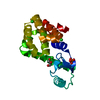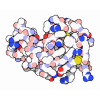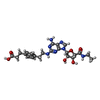[English] 日本語
 Yorodumi
Yorodumi- PDB-8ugw: Computational design of highly signaling active membrane receptor... -
+ Open data
Open data
- Basic information
Basic information
| Entry | Database: PDB / ID: 8ugw | ||||||
|---|---|---|---|---|---|---|---|
| Title | Computational design of highly signaling active membrane receptors through de novo solvent-mediated allosteric networks | ||||||
 Components Components | Endolysin,Adenosine receptor A2a | ||||||
 Keywords Keywords | MEMBRANE PROTEIN / The adenosine a2a receptor | ||||||
| Function / homology |  Function and homology information Function and homology informationregulation of norepinephrine secretion / positive regulation of acetylcholine secretion, neurotransmission / negative regulation of alpha-beta T cell activation / positive regulation of circadian sleep/wake cycle, sleep / Adenosine P1 receptors / G protein-coupled adenosine receptor activity / response to purine-containing compound / G protein-coupled adenosine receptor signaling pathway / NGF-independant TRKA activation / Surfactant metabolism ...regulation of norepinephrine secretion / positive regulation of acetylcholine secretion, neurotransmission / negative regulation of alpha-beta T cell activation / positive regulation of circadian sleep/wake cycle, sleep / Adenosine P1 receptors / G protein-coupled adenosine receptor activity / response to purine-containing compound / G protein-coupled adenosine receptor signaling pathway / NGF-independant TRKA activation / Surfactant metabolism / sensory perception / positive regulation of urine volume / synaptic transmission, dopaminergic / type 5 metabotropic glutamate receptor binding / negative regulation of vascular permeability / synaptic transmission, cholinergic / positive regulation of glutamate secretion / intermediate filament / presynaptic active zone / blood circulation / response to caffeine / eating behavior / inhibitory postsynaptic potential / alpha-actinin binding / regulation of calcium ion transport / asymmetric synapse / axolemma / membrane depolarization / phagocytosis / cellular defense response / prepulse inhibition / positive regulation of synaptic transmission, glutamatergic / viral release from host cell by cytolysis / neuron projection morphogenesis / peptidoglycan catabolic process / astrocyte activation / presynaptic modulation of chemical synaptic transmission / response to amphetamine / central nervous system development / positive regulation of long-term synaptic potentiation / positive regulation of apoptotic signaling pathway / positive regulation of synaptic transmission, GABAergic / regulation of mitochondrial membrane potential / positive regulation of protein secretion / excitatory postsynaptic potential / synaptic transmission, glutamatergic / locomotory behavior / apoptotic signaling pathway / adenylate cyclase-modulating G protein-coupled receptor signaling pathway / negative regulation of inflammatory response / vasodilation / adenylate cyclase-activating G protein-coupled receptor signaling pathway / cell wall macromolecule catabolic process / blood coagulation / lysozyme / lysozyme activity / cell-cell signaling / presynaptic membrane / G alpha (s) signalling events / phospholipase C-activating G protein-coupled receptor signaling pathway / negative regulation of neuron apoptotic process / host cell cytoplasm / postsynaptic membrane / calmodulin binding / positive regulation of ERK1 and ERK2 cascade / defense response to bacterium / response to xenobiotic stimulus / inflammatory response / negative regulation of cell population proliferation / neuronal cell body / apoptotic process / dendrite / lipid binding / regulation of DNA-templated transcription / protein-containing complex binding / glutamatergic synapse / enzyme binding / identical protein binding / membrane / plasma membrane Similarity search - Function | ||||||
| Biological species |  Tequatrovirus T4 Tequatrovirus T4 Homo sapiens (human) Homo sapiens (human) | ||||||
| Method |  X-RAY DIFFRACTION / X-RAY DIFFRACTION /  SYNCHROTRON / SYNCHROTRON /  MOLECULAR REPLACEMENT / Resolution: 3.9 Å MOLECULAR REPLACEMENT / Resolution: 3.9 Å | ||||||
 Authors Authors | Wang, J. / Chen, K.Y. / Lai, J.K. / Russell, A.M. / Conners, K. / Rutter, M.E. / Condon, B. / Tung, F. / Kodandapani, L. / Chau, B. ...Wang, J. / Chen, K.Y. / Lai, J.K. / Russell, A.M. / Conners, K. / Rutter, M.E. / Condon, B. / Tung, F. / Kodandapani, L. / Chau, B. / Zhao, X. / Benach, J. / Baker, K. / Hembre, E.J. / Barth, P. | ||||||
| Funding support |  United States, 1items United States, 1items
| ||||||
 Citation Citation |  Journal: Nat.Chem. / Year: 2025 Journal: Nat.Chem. / Year: 2025Title: Computational design of highly signalling-active membrane receptors through solvent-mediated allosteric networks. Authors: Chen, K.M. / Lai, J.K. / Rudden, L.S.P. / Wang, J. / Russell, A.M. / Conners, K. / Rutter, M.E. / Condon, B. / Tung, F. / Kodandapani, L. / Chau, B. / Zhao, X. / Benach, J. / Baker, K. / Hembre, E.J. / Barth, P. | ||||||
| History |
|
- Structure visualization
Structure visualization
| Structure viewer | Molecule:  Molmil Molmil Jmol/JSmol Jmol/JSmol |
|---|
- Downloads & links
Downloads & links
- Download
Download
| PDBx/mmCIF format |  8ugw.cif.gz 8ugw.cif.gz | 94.3 KB | Display |  PDBx/mmCIF format PDBx/mmCIF format |
|---|---|---|---|---|
| PDB format |  pdb8ugw.ent.gz pdb8ugw.ent.gz | 68.4 KB | Display |  PDB format PDB format |
| PDBx/mmJSON format |  8ugw.json.gz 8ugw.json.gz | Tree view |  PDBx/mmJSON format PDBx/mmJSON format | |
| Others |  Other downloads Other downloads |
-Validation report
| Summary document |  8ugw_validation.pdf.gz 8ugw_validation.pdf.gz | 619.6 KB | Display |  wwPDB validaton report wwPDB validaton report |
|---|---|---|---|---|
| Full document |  8ugw_full_validation.pdf.gz 8ugw_full_validation.pdf.gz | 624.1 KB | Display | |
| Data in XML |  8ugw_validation.xml.gz 8ugw_validation.xml.gz | 16.8 KB | Display | |
| Data in CIF |  8ugw_validation.cif.gz 8ugw_validation.cif.gz | 21.5 KB | Display | |
| Arichive directory |  https://data.pdbj.org/pub/pdb/validation_reports/ug/8ugw https://data.pdbj.org/pub/pdb/validation_reports/ug/8ugw ftp://data.pdbj.org/pub/pdb/validation_reports/ug/8ugw ftp://data.pdbj.org/pub/pdb/validation_reports/ug/8ugw | HTTPS FTP |
-Related structure data
| Related structure data |  2o79S  5iu4S S: Starting model for refinement |
|---|---|
| Similar structure data | Similarity search - Function & homology  F&H Search F&H Search |
- Links
Links
- Assembly
Assembly
| Deposited unit | 
| ||||||||
|---|---|---|---|---|---|---|---|---|---|
| 1 |
| ||||||||
| Unit cell |
|
- Components
Components
| #1: Protein | Mass: 52688.711 Da / Num. of mol.: 1 / Fragment: residues 2-322 Source method: isolated from a genetically manipulated source Source: (gene. exp.)  Tequatrovirus T4, (gene. exp.) Tequatrovirus T4, (gene. exp.)  Homo sapiens (human) Homo sapiens (human)Gene: ADORA2A, ADORA2 / Production host:  |
|---|---|
| #2: Chemical | ChemComp-NGI / |
| Has ligand of interest | Y |
| Has protein modification | Y |
-Experimental details
-Experiment
| Experiment | Method:  X-RAY DIFFRACTION / Number of used crystals: 1 X-RAY DIFFRACTION / Number of used crystals: 1 |
|---|
- Sample preparation
Sample preparation
| Crystal | Density Matthews: 3.15 Å3/Da / Density % sol: 60.98 % |
|---|---|
| Crystal grow | Temperature: 295 K / Method: lipidic cubic phase / pH: 7 Details: 100mM Hepes pH 7 + 27% PEG 300 + 50mM Sodium Potassium Tartrate |
-Data collection
| Diffraction | Mean temperature: 100 K / Serial crystal experiment: N |
|---|---|
| Diffraction source | Source:  SYNCHROTRON / Site: SYNCHROTRON / Site:  Diamond Diamond  / Beamline: I04-1 / Wavelength: 0.9282 Å / Beamline: I04-1 / Wavelength: 0.9282 Å |
| Detector | Type: DECTRIS PILATUS 2M / Detector: PIXEL / Date: May 4, 2016 |
| Radiation | Protocol: SINGLE WAVELENGTH / Monochromatic (M) / Laue (L): M / Scattering type: x-ray |
| Radiation wavelength | Wavelength: 0.9282 Å / Relative weight: 1 |
| Reflection | Resolution: 3.9→66 Å / Num. obs: 6413 / % possible obs: 99.3 % / Redundancy: 6.3 % / Rsym value: 0.129 / Net I/σ(I): 7.2 |
| Reflection shell | Resolution: 3.9→4.11 Å / Num. unique obs: 914 / CC1/2: 0.617 / % possible all: 99.6 |
- Processing
Processing
| Software |
| ||||||||||||||||||
|---|---|---|---|---|---|---|---|---|---|---|---|---|---|---|---|---|---|---|---|
| Refinement | Method to determine structure:  MOLECULAR REPLACEMENT MOLECULAR REPLACEMENTStarting model: 2O79, 5IU4 Resolution: 3.9→66 Å / Cross valid method: THROUGHOUT
| ||||||||||||||||||
| Displacement parameters | Biso max: 345.3 Å2 / Biso mean: 117.3931 Å2 / Biso min: 56.85 Å2 | ||||||||||||||||||
| Refinement step | Cycle: LAST / Resolution: 3.9→66 Å
|
 Movie
Movie Controller
Controller


 PDBj
PDBj











